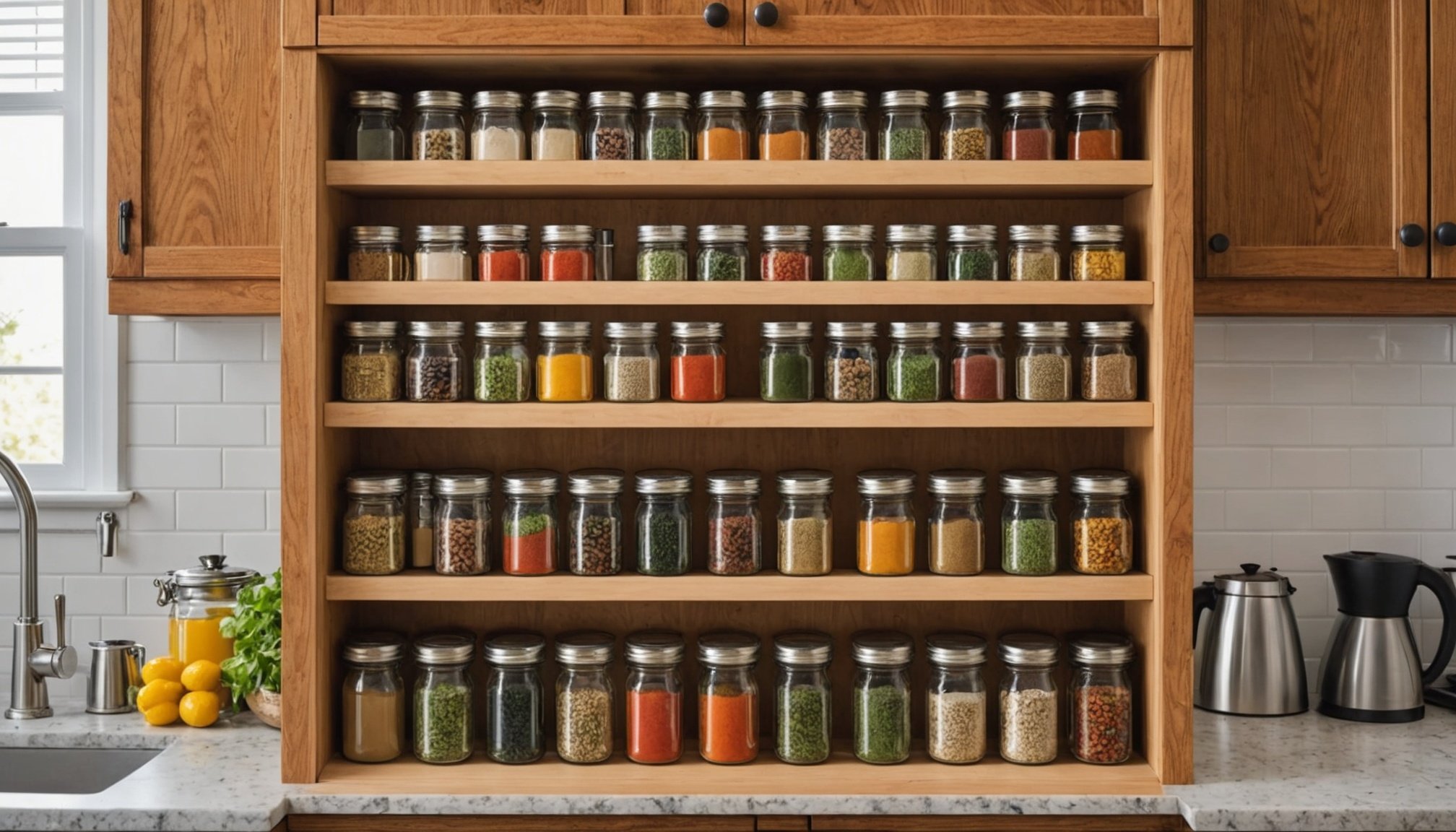Importance of Accessibility in Kitchen Design
Creating a kitchen that prioritises accessibility is crucial for users with diverse needs. Inclusive design principles aim to make kitchens functional for everyone, regardless of physical ability. These principles focus on allowing all users to navigate and use the space effectively.
One of the primary benefits of implementing inclusive design principles is the enhancement of usability, particularly for essential components like spice racks. Accessible spice racks ensure that all users can easily reach and identify spices, which can make cooking more enjoyable and less frustrating.
This might interest you : Ultimate Guide: How to Store Knives Effectively for Long-Lasting Sharpness
Inclusive design integrates features such as adjustable shelves and clear labelling, which cater to a wide range of abilities. By considering the significance of inclusive design, kitchen spaces can foster independence and convenience, transforming the cooking process into an engaging activity for all household members.
Incorporating such accessibility features not only enhances the functionality but also the overall aesthetic of the kitchen. When accessibility is at the forefront of design, the kitchen becomes a welcoming environment, promoting autonomy and satisfaction for every user.
Also read : Digital vs. Analog Kitchen Scales: The Ultimate Choice for Aspiring Beginner Chefs
Planning Your Accessible Spice Rack
Planning an accessible spice rack is essential for a kitchen that caters to all users. It begins by assessing the kitchen layout and understanding the specific needs of its users. Considerations include space availability, reachability, and user capabilities, ensuring that every item is within easy access, which minimises unnecessary strain.
Factors to Consider
- Space: Evaluate where the spice rack can fit without obstructing movement. This can be a wall-mounted, pull-out, or countertop design, depending on the available area and user’s height.
- Reachability: Ensure that the spices are neither too high nor too low, preventing users from stretching or bending excessively.
- User Capabilities: Customizing the rack height to the user’s physical ability can significantly impact accessibility.
Creating sketches or diagrams can help visualise and plan the final design. By investing time in planning, the spice rack becomes a central part of the inclusive design strategy, promoting both independence and enjoyment in cooking activities. Such forethought reflects on the importance of accessibility within the kitchen, providing a seamless experience for all users.
Choosing the Right Materials and Components
When crafting a spice rack, spice rack materials and accessibility features are key considerations. Selecting the right materials ensures durability and ease of use. For instance, lightweight metals like aluminium or durable plastics can provide sturdy, easy-to-clean options. Wood can add a warm aesthetic but requires regular maintenance to avoid wear.
Components that enhance accessibility focus on features such as pull-out shelves and adjustable heights. These elements make it easier for all users to reach and retrieve spices without unnecessary strain, catering to various physical capabilities. Pull-out shelves, for example, allow spices to be brought closer for better visibility and easier access.
When selecting materials, consider safety features. Rounded edges on shelves and non-slip surfaces ensure the spice rack remains safe for all users. It’s also wise to use non-toxic finishes on materials, especially when dealing with items close to food.
By thoughtfully choosing materials and components, the spice rack not only serves its function but also adds to the overall accessibility of the kitchen, ensuring it is both practical and inviting for a diverse range of users.
Step-by-Step Guide to Building Your Spice Rack
Designing a do-it-yourself accessible spice rack begins with gathering necessary tools and materials. Essential tools may include a drill, saw, measuring tape, and screwdriver. For materials, lightweight metals or durable plastics are ideal for sustainability and maintenance.
Constructing the Spice Rack Frame
Start by measuring the intended space for the spice rack, ensuring ample room for accessibility. Cut materials according to these dimensions, and assemble the frame using screws or brackets for sturdiness. Ensure the frame height is tailored to user reachability and that the placement doesn’t obstruct kitchen flow.
Adding Accessibility Features
Incorporate accessibility features to enhance usability. This could include installing pull-out shelves, which allow spices to be drawn closer, ensuring ease of access without excessive stretching. Additionally, add adjustable-height racks to cater to varying user needs. The installation of labelling and easy-to-reach containers further enhances the inclusive design principles, aiding quick spice identification.
By following this guide, the spice rack becomes a key aspect of an accessible kitchen, offering a personalised touch while meeting the diverse needs of all potential users.
Practical Examples of Accessible Spice Racks
Explore real-life solutions with accessible spice racks that delight by blending practicality and design. When surveying well-designed kitchens, features enhancing both form and function stand out as vital components. Successful examples often incorporate inclusive design principles, such as adjustable shelving and pull-out systems, ensuring usability for everyone.
In one case study, a family created a spice rack equipped with pull-down shelves that could be accessed easily by all members, including those using wheelchairs. This design dramatically improved their cooking experience by allowing seamless access to every spice. Such user-friendly designs underscore the impact of accessibility in kitchen design, showcasing how thoughtful adjustments can enhance daily life.
User feedback often highlights the benefits of an accessible spice rack, praising designs that incorporate clear labelling and adjustable features. These elements empower users, offering autonomy in their cooking spaces. A recurring theme in user experiences is that personalized and accessible designs contribute to a more inclusive and engaging kitchen environment, enriching the overall culinary journey.
Maintaining Your Accessible Spice Rack
Regular maintenance of a spice rack is essential to ensure functionality and keep it aligned with accessibility features. Begin by performing routine checks to make sure the spice rack remains organized and usable. Look for misplaced items or obstacles that might hinder ease of access. This routine upkeep helps maintain the inclusivity of the design by ensuring that everything is within easy reach.
Tips for Spices Freshness and Accessibility
To keep spices fresh, store them in airtight containers, which also aids in maintaining an organised and accessible spice rack. Make sure labels are clear and updated to avoid confusion. Regularly rotate spices to bring those that expire sooner to the front, promoting efficient use.
Adapting Over Time
User needs may change, and the spice rack should accommodate these shifts. Consider adjusting shelf heights or modifying container sizes as required. This flexibility ensures the spice rack’s accessibility features continue to meet the varied needs of all users. By thinking ahead and adapting the spice rack over time, you guarantee it remains a functional and inclusive part of your kitchen.











